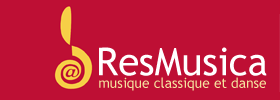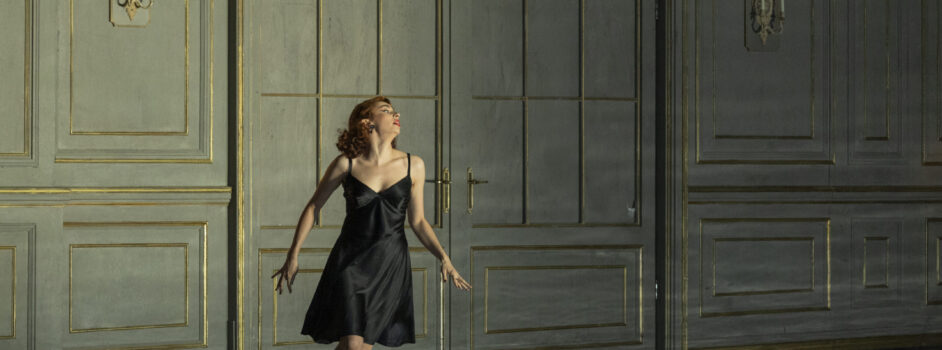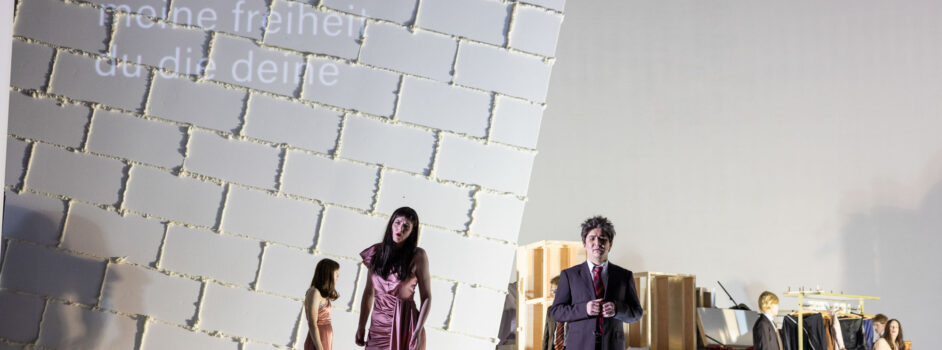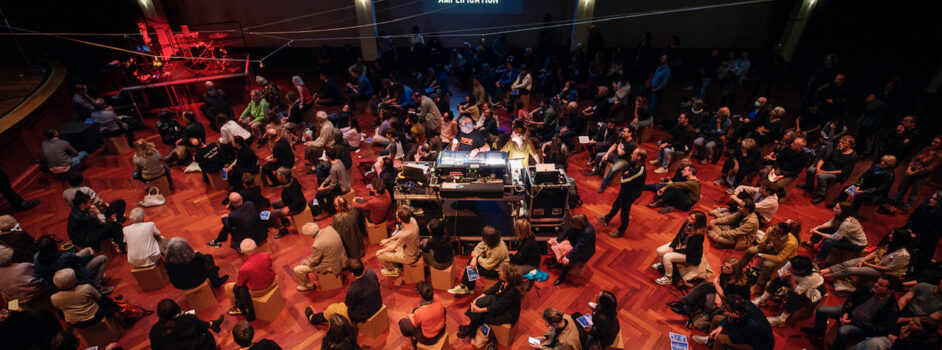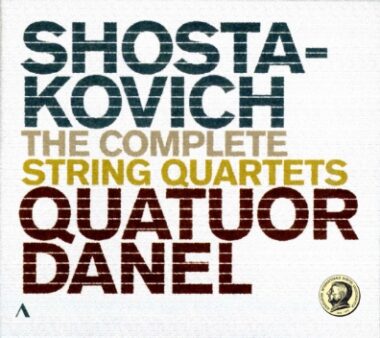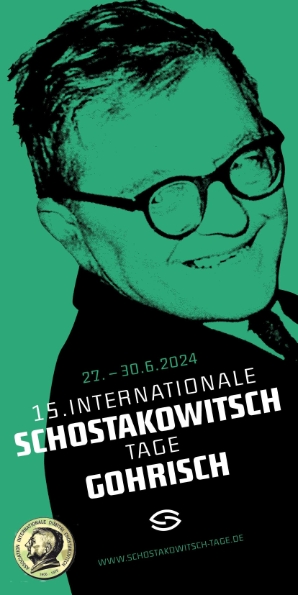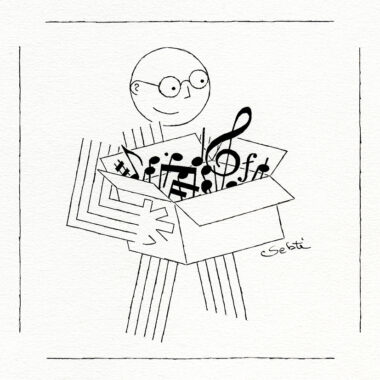Plus de détails
Cité de la Musique .13-XI-2013. Festival d’Automne. Karlheinz Stockhausen (1928-2007) : Trans pour orchestre et électronique ; Bassetsu Trio pour cor de basset, trompette et trombone ; Menschen hört pour sextuor vocal ; Unsichtbare Chöre pour bande magnétique à huit pistes. Marco Blaauw, trompette ; Stephen Menotti, trombone ; Fie Schouten, cor de basset ; Neue Vocalsolisten Stuttgart ; Klaus-Dieter Hesse, réalisation sonore (Trans) ; Kathinka Pasveer, collaboration à la réalisation scénique (Trans) ; Pauk Jeukendrup, réalisation sonore ; Orchestre symphonique de la SWR de Baden-Baden et Fribourg-en-Brisgau, direction : François-Xavier Roth.
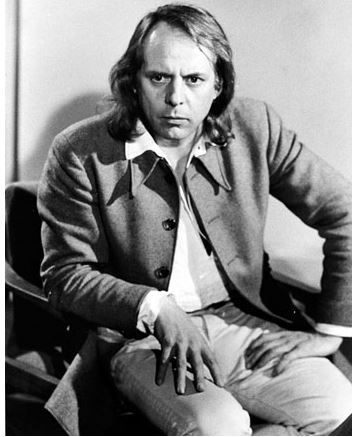 For this concert of the Festival d'Automne, a banner was hung up at the entrance of the Cité de la Musique building. It warned the incoming audience that the Southwest German Radio Symphony Orchestra is in dire situation. Indeed, the German orchestra, which was performing that night under the baton of François-Xavier Roth, celebrating one of Germany's national geniuses, namely Karlheinz Stockhausen, could very well disappear soon. Roth also spoke out at the beginning of the second part of the three-part concert, hoping to mobilize public opinion. A petition, signed by a great many conductors of international repute, has also been addressed to the institutions involved in Germany to persuade them to change their decision.
For this concert of the Festival d'Automne, a banner was hung up at the entrance of the Cité de la Musique building. It warned the incoming audience that the Southwest German Radio Symphony Orchestra is in dire situation. Indeed, the German orchestra, which was performing that night under the baton of François-Xavier Roth, celebrating one of Germany's national geniuses, namely Karlheinz Stockhausen, could very well disappear soon. Roth also spoke out at the beginning of the second part of the three-part concert, hoping to mobilize public opinion. A petition, signed by a great many conductors of international repute, has also been addressed to the institutions involved in Germany to persuade them to change their decision.
The concert was very long, commensurate with this “dreamer of the unheard”: three and a half hours. It began with the symphonic work Trans (1971), which was premiered by this very orchestra under Ernest Bour in Donaueschingen. In accordance with Stockhausen's wishes, it was played twice on the same night. The composer liked to say that he this work came to him in a dream, and then developed it in accordance with personal imagery, both visual and auditory. A huge curtain opens at the beginning of the work, revealing through mauve tulle two rows of string players (without music stands) in ecstatic postures “just like wax statues from a museum” in Stockhausen's words. The strings' mind-bending sonorities, judiciously treated with electronics in order to obtain a light sfumato, must soon compete with the winds and percussion, which are invisible and dispersed, deepening the impression of a dream space.
On the eight tracks of a recorded tape we hear the crashing racket of a loom, the sound of whose mechanism fascinated Stockhausen; this noise periodically troubles the tranquil flow of the strings, and provides the structural ribs of this half-hour-plus long work. The piece is also livened up by three quirky and parodic interventions from a viola, a cello, and a trumpet, the last rising alone above the strings. Later, the strings are set reeling dangerously after a long, enigmatic silence. The reprise of the work after the first intermission partly explains the concert's unusual length.
Bassetsu Trio, for basset horn, trumpet, and trombone, elaborates on an important section of Mittwoch aus Licht (Wednesday, from Light), a cycle of seven operas, each named for one of the days of the week, which Stockhausen composed from 1977 to 2002. The three instrumentalists' virtuosity and flexibility are astounding: Marco Blaauw, Stephen Menotti, and Fie Schoutten are all well versed in Stockhausen-ish asceticism. All three, playing from memory, are required to travel and execute choreographed gestures prescribed by Stockhausen to inscribe their sound in space. The instruments are lightly amplified throughout, with a very beautiful spatial effect at the end of their long journey, when the performers leave the hall, still playing.
Also from Mittwoch aus Licht, Menschen hört (Hark, O Man!) is related to Michaelion, Licht's final scene. The work was performed by the six members of the Neue Vocalisten Stuttgart, who appeared on the first balcony on both sides of the hall, each holding a colored globe representing a planet. Stockhausen specifies the colors of the costume for each singer, who of course perform with no score. Their very pure sound, evocative of sacred choral music, are well suited to the music's uncluttered polyphony, creating a captivating, meditative atmosphere.
The second intermission sent some members of the audience heading for the doors; indeed, it was after 10:30 p.m. when Unsichtbare Chöre (Invisible Choirs)'s forty-seven-minute long eight-track tape was started. This work comes from Donnerstag aus Licht (Saturday, from Light); the tape is played during the opera's first act (Michael's Youth) and includes three intertestamentary texts (that is, dating from the period between the Old and New Testaments; in this case, texts ascribed to Moses and Levi, and from the Syriac Apocalypse of Baruch) in both German and Hebrew. The work is excessively protracted, but this does not at all spoil moments of great beauty in which masses of choral sound resound through the entire space to spectacular effect. Stockhausen allows us to appreciate the beauty of the languages in passages of psalm-like incantation, such as the litany segment that concludes this visionary work with a dark and rugged choral timbre.
Plus de détails
Cité de la Musique .13-XI-2013. Festival d’Automne. Karlheinz Stockhausen (1928-2007) : Trans pour orchestre et électronique ; Bassetsu Trio pour cor de basset, trompette et trombone ; Menschen hört pour sextuor vocal ; Unsichtbare Chöre pour bande magnétique à huit pistes. Marco Blaauw, trompette ; Stephen Menotti, trombone ; Fie Schouten, cor de basset ; Neue Vocalsolisten Stuttgart ; Klaus-Dieter Hesse, réalisation sonore (Trans) ; Kathinka Pasveer, collaboration à la réalisation scénique (Trans) ; Pauk Jeukendrup, réalisation sonore ; Orchestre symphonique de la SWR de Baden-Baden et Fribourg-en-Brisgau, direction : François-Xavier Roth.
